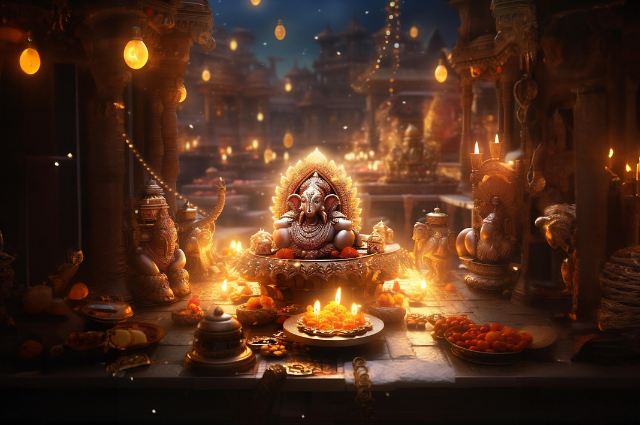
Mythological Origins: The Legends Behind Dhanteras
The significance of Dhanteras is woven from two primary legends deeply rooted in Hindu mythology.
The first and most prominent story is associated with Lord Dhanvantari, the divine physician of the gods and an incarnation of Lord Vishnu. According to the Puranas, Dhanteras marks the day when Dhanvantari emerged from the Samudra Manthan—the great churning of the cosmic ocean of milk by the Devas (gods) and Asuras (demons). From the depths, he arose carrying a kalasha (pot) filled with Amrita, the celestial nectar of immortality.
The appearance of Dhanvantari symbolizes the pursuit of health and holistic well-being. He is revered as the divine propagator of Ayurveda, the ancient Indian system of medicine. Hence, Dhanteras is not merely a celebration of material wealth but is also observed as National Ayurveda Day in India. The worship of Dhanvantari embodies the profound Indic belief that health is the truest form of wealth (ārogyaṁ dhanasaṁpadā)—for without health, no prosperity can truly be enjoyed. Devotees pray to him for a life free from disease and for the strength to live with vitality and purpose.
The second legend linked to Dhanteras is a touching tale of love and triumph over death. It tells of the sixteen-year-old son of King Hima, whose horoscope predicted that he would die of a snakebite on the fourth day after his marriage. On that fateful night, the young prince’s wise and devoted wife refused to let him sleep. She piled her gold and silver ornaments at the entrance of their chamber and lit countless diyas (lamps) all around. Staying awake through the night, she sang songs and told stories to keep her husband from falling asleep.
When Yama, the god of death, arrived in the form of a serpent, he was dazzled by the brilliance of the lamps and the glittering jewels. Blinded and enchanted by the music, he was unable to enter the chamber. Instead, he sat quietly atop the heap of gold, listening to the princess’s melodies throughout the night. As dawn broke, he retreated peacefully, sparing the prince’s life.
This legend gave rise to the tradition of lighting the Yama Deepam—a single oil lamp kept burning through the night outside the house, facing the south (the direction associated with Yama). The ritual is performed to appease the god of death and to pray for the longevity and well-being of one’s family, symbolizing protection from untimely death.
Rituals and Celebrations: Welcoming Prosperity
The celebration of Dhanteras is marked by a series of beautiful and meaningful rituals that prepare households for the arrival of Goddess Lakshmi, the goddess of wealth, during Diwali.
The day begins with the cleansing and decoration of homes and workplaces. Spaces are meticulously cleaned, decluttered, and sometimes whitewashed. This act of purification symbolizes the removal of negativity and the creation of a sacred, welcoming environment filled with positive energy. Entrances are adorned with rangoli designs and small footprints drawn with rice flour and vermilion, representing the arrival of Goddess Lakshmi. As evening descends, the entire house glows with rows of diyas, creating an atmosphere of warmth and devotion.
A hallmark tradition of Dhanteras is the purchase of new items, considered highly auspicious. People buy precious metals such as gold and silver, often as jewelry or coins bearing the images of Goddess Lakshmi and Lord Ganesha. Others buy new utensils made of brass, copper, or silver. This act of purchase is not merely commercial; it symbolizes inviting prosperity and good fortune into the home for the coming year. Markets bustle with life, and jewelry and utensil shops thrive in celebration of abundance and gratitude.
In the evening, devotees perform a special puja dedicated to Lord Dhanvantari, Goddess Lakshmi, and Lord Kubera, the treasurer of the gods. Offerings of flowers, incense, fruits, and traditional sweets—especially those made from jaggery and coriander seeds—are made. The newly purchased items are placed on the altar to be blessed during the ritual, sanctifying both material and spiritual prosperity.
Conclusion: A Holistic Celebration of Life
Dhanteras beautifully encapsulates the Indian worldview of prosperity as a holistic ideal that goes far beyond material wealth. Through the veneration of Lord Dhanvantari, the day emphasizes the primacy of health and well-being. Through the worship of Goddess Lakshmi and Lord Kubera, it celebrates material abundance and financial stability. And through the Yama Deepam ritual, it honors the sanctity of life itself—praying for protection, longevity, and balance.
At its heart, Dhanteras is a day of gratitude and renewal. It invites us to cleanse not only our homes but also our minds, to honor the sources of our well-being, and to welcome divine energies of health, wealth, and happiness. As it sets the tone for Diwali, Dhanteras reminds us that the brightest light is not just the one that illuminates our homes—but the one that shines from within, kindled by health, harmony, and inner contentment.
. . .
References
